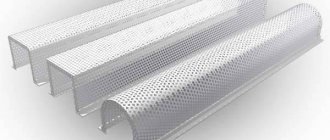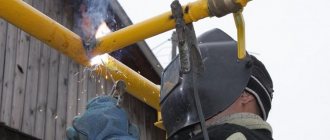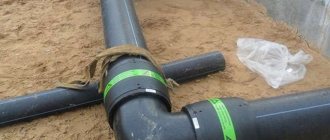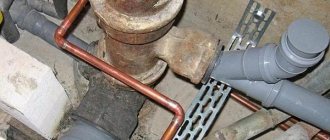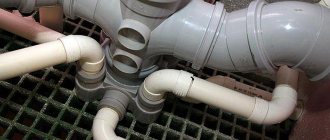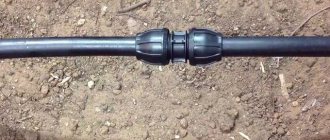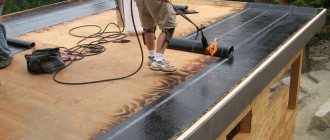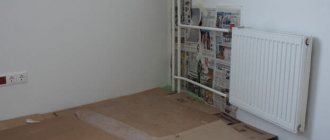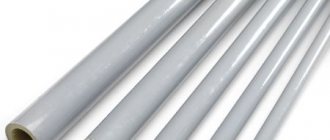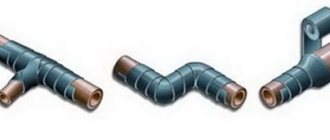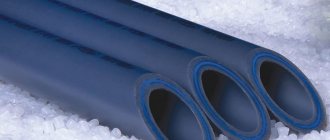15.09.2020
Issues discussed in the material:
- Types of water pipelines and proper welding of pipes
- How to choose electrodes for proper pipe welding
- Methods and tips for proper pipe welding
- Preliminary work for proper pipe welding
- Correct pipe welding: step-by-step algorithm
- Safety precautions when welding pipes
Proper welding of pipes is a real art that allows you to create durable plumbing. Often, households use inexpensive and lightweight plastic pipes or easy-to-install profiles. However, these options are not always practical.
In order for the water supply to serve for a long time, it is important to correctly organize the entire work process: from the choice of electrode to the welding technology.
Types of water pipelines and proper welding of pipes
A variety of pipelines are used to move different materials and fluids. Depending on their purpose, they can be:
- technological;
- main lines;
- industrial;
- gas supply pipelines;
- water;
- sewer.
Pipelines are made of ceramics, plastics, concrete and metals.
Proper welding of pipes is carried out in one of the following ways:
- Mechanical, in which the result is achieved through friction.
- Thermal, during which materials melt (gas, plasma, electric arc welding).
- Thermomechanical, which is performed by butt contact method using a magnetically controlled arc.
Types of welding can be classified on various bases. Before you start processing pipes, you should choose the most suitable method. Theoretically, any of them is suitable for working with pipes of different diameters. Pipelines can be welded using pressure (gas press, cold, ultrasonic and contact welding) or melting (electric arc and gas). Most often, manual or mechanized electric arc methods are used to properly weld pipe joints.
How to choose electrodes for proper pipe welding
Before you start welding heating pipes or any other pipes, you need to stock up on electrodes. Their quality directly affects the reliability of the resulting connection, the tightness of the structure, as well as the welding process itself.
Electrodes are a thin steel rod with a special coating that provides a stable arc during operation and forms a weld that prevents oxidation of the metal.
Electrodes are qualified by the type of core and outer coating.
Depending on the type of core, electrodes are divided into:
- consumables with a non-melting center made of graphite, electrical coal or tungsten;
- with a melting center - wire, the thickness of which varies depending on the type of work performed.
Based on the type of external coating, electrodes are divided into the following groups:
- With cellulose coating (grade C). Designed for proper welding of large diameter pipes; they are used to install gas and water mains.
- With rutile acid coating (RA). Used to work with metal heating or drainage pipes. The resulting weld is covered with a small layer of slag, which is removed by tapping.
- Rutile coated (RR). Allows you to obtain neat welding seams with slag that can be easily removed from the surface. These electrodes are used for corner joints, as well as when welding the second or third layers of metal.
- With rutile cellulose (RC) coating. They can be used for correct welding of pipes in any planes, for example, when creating a long vertical seam.
- With base coat (B). These are universal consumables suitable for working with thick-walled pipes and parts intended for use at sub-zero temperatures. Allows you to obtain a high-quality plastic seam that is not subject to cracking or deformation.
Before starting welding work, it is worth obtaining advice from welding specialists regarding their preferred brands of electrodes. At the same time, there can be quite a lot of recommendations, and consumables may vary depending on the store or city.
Recommended reading
- Cutting copper with a laser: advantages and disadvantages of technology
- Types of metal cutting: industrial applications
- Metalworking according to drawings: convenient and profitable
There is a direct connection between the cost and quality of consumables. With cheap electrodes it is difficult to weld pipes correctly and obtain a high-quality weld. Therefore, there is no need to save on these consumables.
Methods for proper pipe welding
There are various methods for properly welding polypropylene pipes and products made from other materials using the electric arc method:
- end-to-end - in this case the pipeline elements are located opposite each other;
- in a T-bar - in this case, the pipe sections are located perpendicular to each other (in the shape of the letter “T”);
- overlap - this method involves flaring one of the pipes, allowing it to be put on the other;
- angular method, in which the elements are placed at an angle of 45° or 90° relative to each other.
In the process of proper pipe welding, the following types of seams are obtained:
- horizontal (with a vertical arrangement of pipeline elements);
- vertical (if the pipes are located vertically);
- ceiling (with the electrode placed above the welder’s head, in the lower part of the workpiece);
- lower ones (you have to bend over to do this).
If it is necessary to connect steel pipes, the butt method is used. In addition, the joint must be welded to the thickness of the workpiece wall. A bottom turning seam is best for this.
To obtain a high-quality welded joint during the work process, you should adhere to the following recommendations:
- During welding, the electrode should be positioned at an angle of 45° or slightly less. This will reduce the amount of molten metal entering the pipeline element being welded.
- For T-welding or butt welding, 2-3 mm electrodes will be required. A high-quality welded joint will be obtained with a current varying from 80 to 110 amperes.
- To get a reliable overlap connection, you will need to increase the current to 120 amperes; 2-3 mm consumables (electrodes) are also suitable.
- The weld seam should rise 3 mm below the surface of the workpiece being welded, after which we can talk about completing the work.
Correct welding of profile pipes is carried out spot-welding, that is, first two points located on opposite sides of the profile are welded, then two other points, continuing work until the entire pipe is heated. Next, a welding seam is formed along the entire perimeter of the workpiece.
Features of pipe welding
When welding steel pipelines, gas and electric welding are most often used. When installing high-pressure pipe structures, special requirements are placed on electrodes and filler wire. The layering of the joints depends on the wall thickness:
- weld a joint up to 3 mm inclusive at a time;
- over 3 to 6 mm, two penetrations must be made;
- over 6 to 12 mm - create a three-layer connection;
- over 12 mm it is better to go through the joint at least 4 times.
In pipe welding technology there are distinctive features of the choice of operating current:
- amperage is selected according to the diameter of the electrode, multiplying the indicator by 35 (3 mm - 105 A, 4 mm - 140 A);
- when welding pipes with a wall thickness of less than 4 mm, a current exceeding 150 A is not installed;
- between the electrode and the rolled product, a distance equal to the thickness of the electrode plus 1 mm is maintained;
- thin-walled rolled products are welded in one continuous pass, turning the rolled products, thick-walled rolled products can be welded in sections up to 15 cm long;
- vertical and non-rotary joints are welded in two stages;
- The melt pool is located 30° from the top point.
The finishing layer roller should protrude up to 3 mm above the pipe. The quality of the connection is checked after each penetration, when the scale is removed.
Preliminary work for proper pipe welding
Before you begin to properly weld plastic and metal round pipes, you need to pre-process the joints and clarify a number of nuances. First of all, they diagnose the pipe’s compliance with certain technical characteristics that apply to the installed system, in particular to the water supply system.
Necessary:
- observe geometric dimensions;
- have a quality certificate, especially if a pipeline for drinking water supply is to be installed;
- so that the pipe is perfectly round in shape, since defects, a flattened or oval section of the workpiece are not acceptable;
- control the wall thickness along the entire length of the pipe - it should be the same;
- The chemical composition of the part must comply with the requirements of GOST - this information is contained in the technical documentation or is determined in the process of laboratory research.
After this, you can begin preparing the pipes for joining and welding.
During the preparation process, you must complete the following steps:
- check the evenness of the cut at the end of the pipe, it should be 90°;
- thoroughly clean the end of the workpiece to be welded and the 10 mm area around it until a metallic sheen appears;
- remove residual oils, rust, paintwork from the surface of the pipe, degrease the ends of the element.
In addition, you should ensure that the end has the correct configuration. The opening angle of the edge should be 65°, the dullness index should be 2 mm. The required parameters can be obtained through additional processing.
Correct pipe welding: step-by-step algorithm
In electric welding, a strong connection between workpieces is achieved through a thermal process. In this case, the quality of the seam will be higher than with gas welding.
If the pipes are located in an accessible place and can be rotated, then it is necessary to connect the two pipeline elements end-to-end with one or three electric welding points, and then continue welding the workpieces:
- continuously (if it is possible to rotate the parts);
- with a separation, starting from the bottom, if the pipe is located inconveniently and there is no way to rotate it.
Welding work is performed in two approaches. Initially, the first seam (“root”) is made, covering 2-3 mm of the joint of the workpieces, after which the resulting deposits and scale are removed. Then a second seam is formed, which is also cleaned.
The algorithm for proper pipe welding is as follows:
- Before you start working directly, you need to take a stable position and take care of good lighting of the space.
- Light the arc, increasing the current if necessary.
- Place the electrode at the beginning of the weld, form a weld pool, maintaining a constant arc gap.
- A sufficiently large current will cause particles of straightened metal to follow the heat.
Movements must be adjusted and careful, since too much current will cause the metal to melt too much, begin to bubble, and it will not be possible to form a weld. - In the process of properly welding pipes, it is necessary to ensure that the edges are filled and that there are no undercuts.
If the current is low, then the weld pool will be equal to the outline of the electrode. By increasing the current, moving the electrode in a circle or from side to side, you can form the correct welding seam. Attention should be paid to the quality of welding during the processing of workpieces, ensuring the uniform filling of the weld pool. - Place a point, leaving a small amount of metal.
- Extinguish the arc along the seam.
Over time, you can learn how to properly weld pipes and form high-quality seams, but it will be easier for those who previously observed the work from the outside or were a welder’s assistant.
Pipe welding technology
All problems associated with thermal connection technology, the choice of materials and equipment, and ensuring the safety of welding operations are regulated by the main document GOST 16037 80. Steel pipelines are manufactured in several ways. Household connection of elements without transition, when installation is done by hand, is usually carried out using an inverter apparatus - this greatly simplifies the thermal process and ensures safety.
This device is connected to a 220 V home network. Then the frequency of the current in it is increased (inverted), and which is then rectified. The bonding process is carried out using direct current. For beginners it is much easier and safer. The quality of the connection does not suffer. The price of such a device ranges from 5 to 10 thousand rubles. Connection work begins with general preparatory work. From the very beginning you need to choose your tools. The metal and coating of the tools are selected - what protects the seam.
Electrodes that melt are used in everyday life. Various materials are used in the coating to form a protective layer. Welded inserts come in various types: butt, overlap, tee (perpendicular), corner. Pipes of the same diameter and the same wall thickness are usually butted together. Elements of different diameters are interconnected with an overlap. In this case, a pipe of a smaller external diameter is inserted into a larger one.
If the pipes have the same outer diameter, but different wall thicknesses, then the thin-walled one is slightly flared, and the thick-walled one is inserted into it. The seam is placed over the outside of both pipes. Assembly of complex configurations is carried out according to the drawing. For ease of operation, individual parts after installation are clamped in a special device with clamps.
A T-joint assumes that the elements are connected at a right angle (90 degrees). An angular option is called when the indicator is equal to, for example, 45 degrees. Round pipes of small diameter are welded with a single seam, without removing the tool from the surface of the product. If the procedure began at one point on the circle, then it should end at that same point. The tool must not come off the parts being connected.
The connection of pipes with a diameter greater than 110 mm (large diameter) is carried out using several techniques and a method in several layers. Subsequent layers are applied in the opposite direction to the previous one. Each layer must be scraped off from slag. If necessary, the elements that are welded have to be rotated. Rotation angle in the range of 60 – 110 degrees. This is a convenient area for the welder. After each turn, only part of the entire seam is welded. The entire seam will be multi-layered.
If the joints are non-rotating, then the action begins from the lowest point. After welding, the fresh seam is covered with a thermal belt to ensure its insulation from the effects of external conditions (uncontrolled cooling at an increased rate).
The quality of a weld in a non-rotating position is checked first visually, then using special equipment - flaw detectors, and sometimes using destructive testing. It is imperative to ensure that there is no gap between the welded ends of the pipe, so that the entire seam is filled with metal.
Safety precautions when welding pipes
During electrical work, including pipe welding, it is necessary to comply with safety requirements. Their violation can result in various injuries, for example, thermal burn of the skin or retina due to an arc flash, electric shock, etc.
To avoid trouble, you should pay attention to the following before starting work:
- electrical wires and parts of the welding machine must be insulated;
- the body of the welding equipment and additional devices must be grounded;
- You can only wear completely dry overalls and gloves;
- for additional insulation it is necessary to use galoshes or a rubber mat (for a small room);
- Be sure to protect your eyes and face by wearing a protective shield.
By following the information presented in the article, you can independently learn how to properly weld pipes using electrical equipment. However, it is impossible to achieve success without practical skills. Using our recommendations, you can start practicing welding and over time get decent results in welding metal pipelines.
Manual arc welding methods for pipes
There are two main methods of manual electric arc welding of pipes: rotary and fixed. In practice, the possibility of their use is dictated by the technical features of the pipes, their location and the qualifications of the welder. There is also a combined method, but it has not found widespread use.
Welding with joint rotation
The rotating method ensures maximum strength and uniformity of the seam. This can be achieved using two tricks. Firstly, try to keep the electrode strictly at a right angle to the axis of the pipe, that is, regulate the intensity of melting not by tilting the electrode, but by the length of the arc. Secondly, work using three-pass technology. It involves the following sequence of actions:
- Conventionally divide the end of the pipe into four equal segments , you can make corresponding marks, but it is better to weld the pipes in these zones point by point.
- Boil the joint in the root part of the segments located opposite each other with a thin electrode (3-4 mm) with a current of 120-150 A.
- Rotate the pipe 90° and weld the remaining two segments with the same parameters.
- Gradually turning the pipe, weld it over its entire diameter . The welding parameters will also change - the electrode size will be 5-6 mm, and the current will be 200-250 A.
- Repeat the steps indicated in point 4.
If the design involves welding pipes on the same axis in several sections, perform operations simultaneously at all joints. This will not only speed up the work, but will also prevent any axial displacement during the welding process.
Welding without joint rotation
Welding without rotation is advisable when it is carried out on an already assembled structure, including those with hard-to-reach places. The technology is in many ways similar to rotary, but there are a number of significant differences in the length of individual seams. The general algorithm includes the following steps:
- A thin electrode (4 mm) is used to weld up to half the length of the joint..
- The remaining segment is conventionally divided into two equal parts , which are welded with a thin electrode in different directions.
- Half of the joint is re-welded with a thick electrode (5-6 mm), and it should not exactly repeat the location of the very first seam, but should partially overlap it (about 30°).
- The remaining segment is conventionally divided into two equal parts and welded with a thick electrode in different directions.
The third pass is usually used only when welding pipes with a diameter greater than 700 mm. It involves applying two seams of equal length in opposite directions, the joints of which do not coincide with the joints of the seams applied previously.

